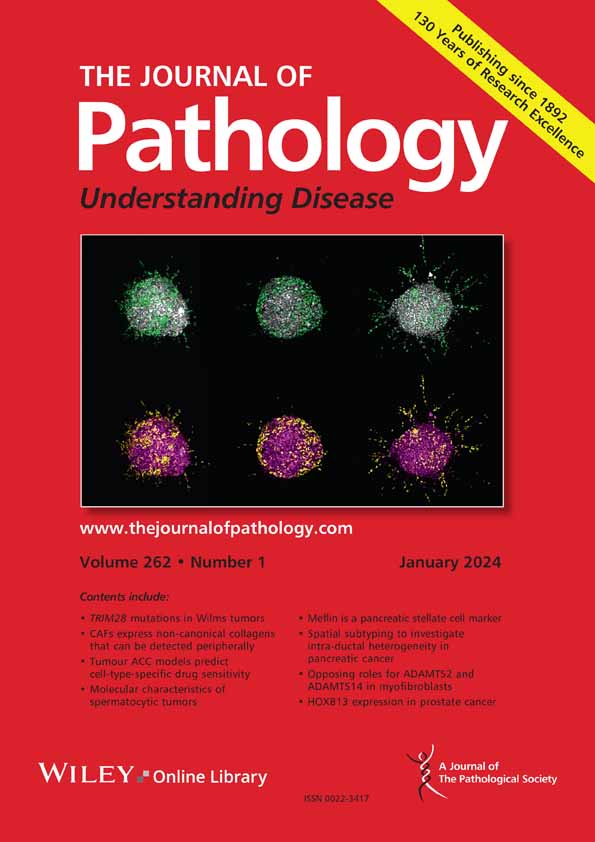Zhanzhan Li, Baishuang Yang, Meihua Long, Jiarong Chen, Yaofeng Zhi, Ronggang Li, Lixue Cao, Shasha Yang, Jingyi Sun, Zijie Meng, Wanting Wu, Yanyang Mai, Xin Zhang, Yanming Huang, Qiong Chen, Aibin Liu
求助PDF
{"title":"Silencing GRHL3 promotes multiple organ distant metastasis of lung squamous cell carcinoma cells by enhancing SOX2 stability via SIRT1","authors":"Zhanzhan Li, Baishuang Yang, Meihua Long, Jiarong Chen, Yaofeng Zhi, Ronggang Li, Lixue Cao, Shasha Yang, Jingyi Sun, Zijie Meng, Wanting Wu, Yanyang Mai, Xin Zhang, Yanming Huang, Qiong Chen, Aibin Liu","doi":"10.1002/path.6385","DOIUrl":null,"url":null,"abstract":"<p>Aberrant expression of grainyhead-like transcription factor 3 (GRHL3) has been extensively reported in the development and progression of several squamous cell carcinomas, such as cutaneous, head and neck, and esophageal squamous cell carcinoma. However, the clinical significance and biological roles of GRHL3 in lung squamous cell (LUSC) carcinoma are largely unclear. Herein, we report that GRHL3 was significantly upregulated in lung squamous epithelium of LUSC tissues, bronchiole, and bronchus. Moreover, expression levels of GRHL3 were decreased with the advance of pathological grade, and low GRHL3 level presented poor overall survival and short progression-free and distant metastasis-free survival in LUSC patients but had no prognostic significance in LUAD patients. Functional experiments <i>in vivo</i> showed that downregulating GRHL3 promoted not only lung colonization and growth but also multiple organ distant metastasis of LUSC cells, including bone, brain, and liver. Moreover, silencing GRHL3 promoted anoikis resistance and cancer stem cell (CSCs) characteristics of LUSC cells <i>in vitro</i>. Mechanistically, silencing GRHL3 stabilized SOX2 via SIRT1-mediated decreasing acetylation and subsequent ubiquitination-dependent degradation in LUSC cells. Thus, in-depth understanding of the underlying mechanism of GRHL3 in the progression of LUSC will facilitate the development of prognostic biomarker and therapeutic avenues against LUSC, which will present favorable prospects in improving outcomes of LUSC patients. © 2025 The Pathological Society of Great Britain and Ireland.</p>","PeriodicalId":232,"journal":{"name":"The Journal of Pathology","volume":"265 3","pages":"302-315"},"PeriodicalIF":5.6000,"publicationDate":"2025-01-13","publicationTypes":"Journal Article","fieldsOfStudy":null,"isOpenAccess":false,"openAccessPdf":"","citationCount":"0","resultStr":null,"platform":"Semanticscholar","paperid":null,"PeriodicalName":"The Journal of Pathology","FirstCategoryId":"3","ListUrlMain":"https://onlinelibrary.wiley.com/doi/10.1002/path.6385","RegionNum":2,"RegionCategory":"医学","ArticlePicture":[],"TitleCN":null,"AbstractTextCN":null,"PMCID":null,"EPubDate":"","PubModel":"","JCR":"Q1","JCRName":"ONCOLOGY","Score":null,"Total":0}
引用次数: 0
引用
批量引用
Abstract
Aberrant expression of grainyhead-like transcription factor 3 (GRHL3) has been extensively reported in the development and progression of several squamous cell carcinomas, such as cutaneous, head and neck, and esophageal squamous cell carcinoma. However, the clinical significance and biological roles of GRHL3 in lung squamous cell (LUSC) carcinoma are largely unclear. Herein, we report that GRHL3 was significantly upregulated in lung squamous epithelium of LUSC tissues, bronchiole, and bronchus. Moreover, expression levels of GRHL3 were decreased with the advance of pathological grade, and low GRHL3 level presented poor overall survival and short progression-free and distant metastasis-free survival in LUSC patients but had no prognostic significance in LUAD patients. Functional experiments in vivo showed that downregulating GRHL3 promoted not only lung colonization and growth but also multiple organ distant metastasis of LUSC cells, including bone, brain, and liver. Moreover, silencing GRHL3 promoted anoikis resistance and cancer stem cell (CSCs) characteristics of LUSC cells in vitro . Mechanistically, silencing GRHL3 stabilized SOX2 via SIRT1-mediated decreasing acetylation and subsequent ubiquitination-dependent degradation in LUSC cells. Thus, in-depth understanding of the underlying mechanism of GRHL3 in the progression of LUSC will facilitate the development of prognostic biomarker and therapeutic avenues against LUSC, which will present favorable prospects in improving outcomes of LUSC patients. © 2025 The Pathological Society of Great Britain and Ireland.
沉默GRHL3通过SIRT1增强SOX2稳定性促进肺鳞癌多器官远处转移。
颗粒头样转录因子3 (granyhead -like transcription factor 3, GRHL3)的异常表达在几种鳞状细胞癌(如皮肤、头颈部和食管鳞状细胞癌)的发生和进展中已被广泛报道。然而,GRHL3在肺鳞细胞(LUSC)癌中的临床意义和生物学作用在很大程度上尚不清楚。在此,我们报道GRHL3在LUSC组织、细支气管和支气管的肺鳞状上皮中显著上调。此外,GRHL3的表达水平随着病理分级的提高而降低,GRHL3水平低在LUSC患者中表现为较差的总生存期、较短的无进展和远处转移生存期,而在LUAD患者中无预后意义。体内功能实验表明,下调GRHL3不仅能促进LUSC细胞在肺中的定植和生长,还能促进LUSC细胞在骨、脑、肝等多器官的远处转移。此外,沉默GRHL3可促进体外LUSC细胞的anoikis抗性和肿瘤干细胞(cancer stem cell, CSCs)特性。在机制上,沉默GRHL3通过sirt1介导的降低乙酰化和随后的泛素化依赖性降解在LUSC细胞中稳定SOX2。因此,深入了解GRHL3在LUSC进展中的潜在机制将有助于开发针对LUSC的预后生物标志物和治疗途径,这将为改善LUSC患者的预后提供良好的前景。©2025英国和爱尔兰病理学会。
本文章由计算机程序翻译,如有差异,请以英文原文为准。

 求助内容:
求助内容: 应助结果提醒方式:
应助结果提醒方式:


